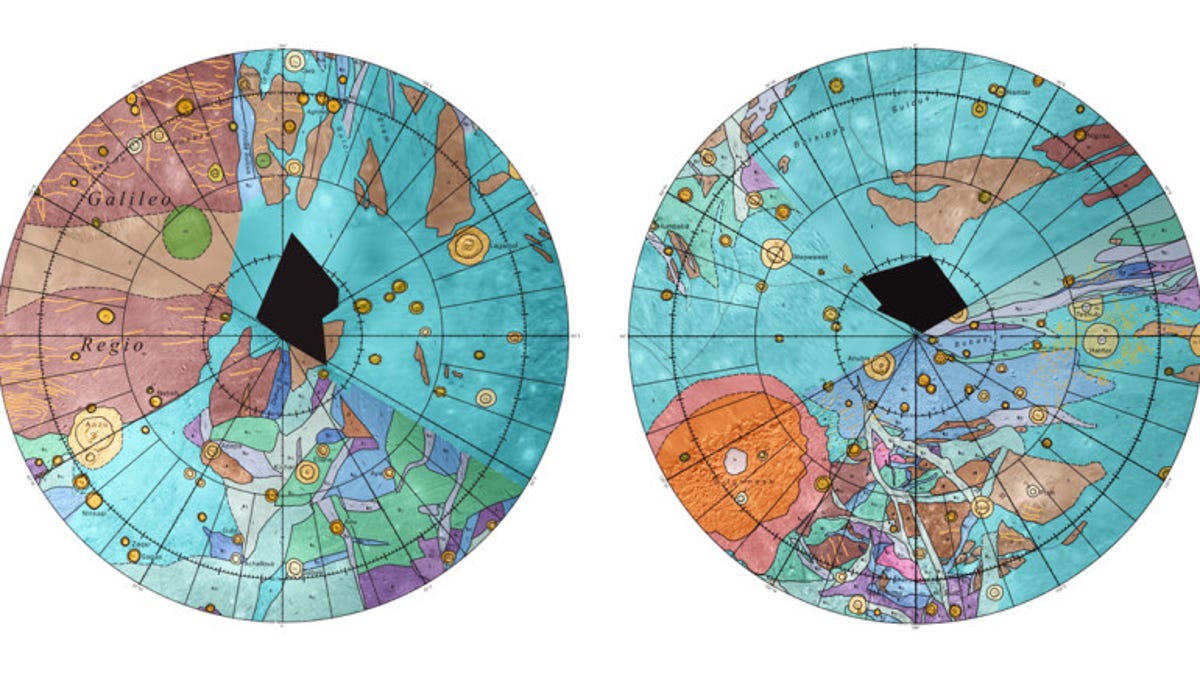Adorn your wall with free map of solar system's biggest moon
Lots of people have maps of the Earth festooning their walls. Now you can be one of the first to have a map of Ganymede, Jupiter's icy moon, on yours.
Dukug Sulcus. Adapa. Lagamal. Wepwawet. Humbaba. They sound like names of places in a lost installment of "Firefly," but they're real. Yes, they're 390,400,000 miles away, but real nonetheless.
These geological features are found on Ganymede, one of Jupiter's gigantic moons. They're detailed in a new map published by the U.S. Geological Survey from a team of scientists led by Wes Patterson of the Johns Hopkins Applied Physics Laboratory and Geoffrey Collins of Wheaton College. The map can be downloaded here and measures a generous 58x41 inches.
The map shows both circular renderings of Ganymede's north and south poles as well as a flat Mercator-style projection of the rest of the moon. It's color-coded to highlight various geological features that have been formed over Ganymede's three geological phases. These phases, according to the U.S. Geological Survey, include "an early phase dominated by impact cratering and mixing of non-ice materials in the icy crust, a phase in the middle of its history marked by great tectonic upheaval, and a late quiescent phase characterized by a gradual drop in heat flow and further impact cratering."
A handy chart of the meanings of the different colors is included along the right side of the map, and a series of symbols with explanations helps you distinguish between features like depressions, crater rims, and domes.
The maps were created using data obtained from NASA's Voyager and Galileo missions and is the fourth such map covering a moon ever made. According USGS Astrogeology Science Center Director Laszlo Kestay, it's considered an important tool in evaluating the moon for signs of life.
"After Mars, the interiors of icy satellites of Jupiter are considered the best candidates for habitable environments for life in our solar system," he said. "This geologic map will be the basis for many decisions by NASA and partners regarding future U.S. missions under consideration to explore these worlds."
Ganymede is not only Jupiter's biggest moon, it's the largest one in our solar system, bigger even than Mercury and one-time-planet Pluto, with a diameter of 3,280 miles. Daytime temperatures on the satellite average a brisk -171 degrees Fahrenheit to -297 degrees Fahrenheit with nighttime temps plunging to -315 degrees Fahrenheit. It's considered one of Jupiter's "Galilean" moons because it was discovered by Galileo Galilei in 1610. He named it Jupiter III back then, but it got its much cooler name -- after a famous Trojan prince in Greek mythology -- in the mid-1800s.
Given that map's size, you could send it out to one of those "print on canvas" places for a pretty cool addition to your wall art. You'll really be the talk of the town if you put a few pushpins on it and leave the meaning up to your guests' imaginations.


